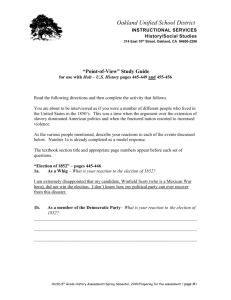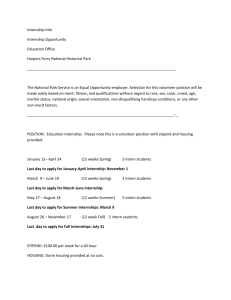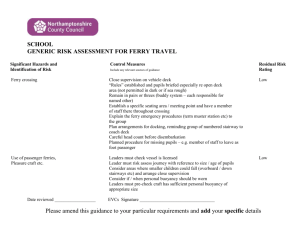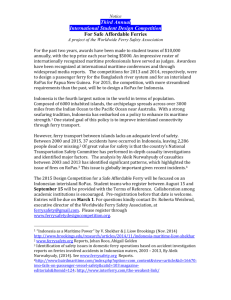John Brown: Hero or Terrorist
advertisement
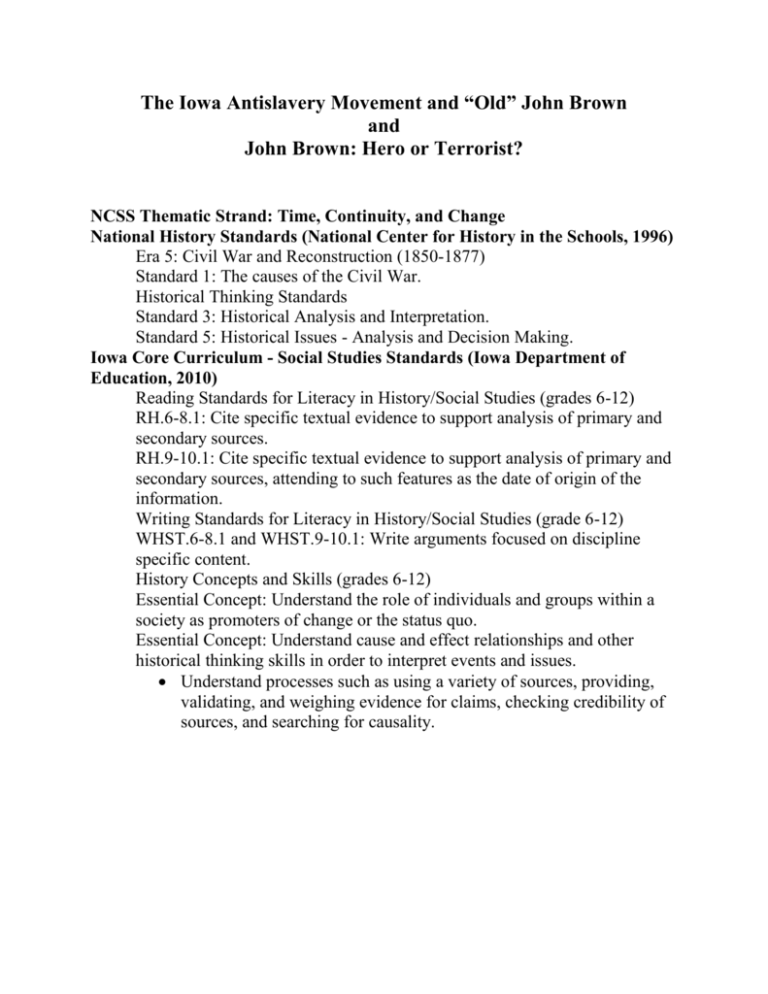
The Iowa Antislavery Movement and “Old” John Brown and John Brown: Hero or Terrorist? NCSS Thematic Strand: Time, Continuity, and Change National History Standards (National Center for History in the Schools, 1996) Era 5: Civil War and Reconstruction (1850-1877) Standard 1: The causes of the Civil War. Historical Thinking Standards Standard 3: Historical Analysis and Interpretation. Standard 5: Historical Issues - Analysis and Decision Making. Iowa Core Curriculum - Social Studies Standards (Iowa Department of Education, 2010) Reading Standards for Literacy in History/Social Studies (grades 6-12) RH.6-8.1: Cite specific textual evidence to support analysis of primary and secondary sources. RH.9-10.1: Cite specific textual evidence to support analysis of primary and secondary sources, attending to such features as the date of origin of the information. Writing Standards for Literacy in History/Social Studies (grade 6-12) WHST.6-8.1 and WHST.9-10.1: Write arguments focused on discipline specific content. History Concepts and Skills (grades 6-12) Essential Concept: Understand the role of individuals and groups within a society as promoters of change or the status quo. Essential Concept: Understand cause and effect relationships and other historical thinking skills in order to interpret events and issues. Understand processes such as using a variety of sources, providing, validating, and weighing evidence for claims, checking credibility of sources, and searching for causality. Grade Level: 8-12 Class Periods Required: “The Iowa Underground Railroad and ‘Old’ John Brown: Iowa’s Role in the Antislavery Movement” – 50 minutes Introduction to “John Brown: Hero or Terrorist?” and “John Brown’s Life before the Harpers Ferry Raid and the Planning of the Raid” – 2 class periods (approximately 100 minutes) “John Brown’s Raid on Harpers Ferry, Virginia” – 2 class periods (approximately 100 minutes) “The Trial of John Brown” – 50 minutes “The Aftermath of John Brown’s Trial” – 50 minutes Sum Up Discussion and Interpretive Assignment – 50 minutes Purpose, Background and Context This unit deals with the continuing struggle between proslavery and antislavery proponents which culminated, in 1861, with the secession of eleven Southern states and the beginning of the Civil War. The lessons would most appropriately be taught both as a prelude to the Civil War and as a culmination of the heightened sectional conflict resulting from the passage of the Fugitive Slave Law (1850), the Kansas-Nebraska Act (1854), “Bleeding Kansas” (1855-1856), and the Dredd Scott decision (1857). The unit provides a variety of perspectives on John Brown’s raid on Harpers Ferry, Virginia and the ensuing historical interpretations of his character and purpose. Objectives Students will: Understand the nature and scope of the antislavery movement, both nationally and in Iowa, in the 1850s. Understand the role played by Iowans in the planning and execution of John Brown’s famous raid on Harpers Ferry, Virginia (Oct. 16-18, 1859). Use a variety of sources, including primary documents, to analyze John Brown’s motives and beliefs for the decision to invade Harpers Ferry and seize the federal arsenal located there. Use a variety of sources, including primary documents, to analyze the motives and beliefs of some of John Brown’s followers at Harpers Ferry. Use contemporary newspaper accounts to examine the Harpers Ferry raid from a variety of historical perspectives and to explore how the raid exacerbated sectional tensions and contributed to the coming of the Civil War. Analyze John Brown’s statements following his capture at Harpers Ferry and evaluate their historical accuracy by comparing his account to the historical record. Evaluate John Brown’s actions at Harpers Ferry from a variety of perspectives, including practical, legal and moral. Materials: Reading: “The Iowa Underground Railroad and ‘Old’ John Brown: Iowa’s Role in the Antislavery Movement” A study guide covering “The Iowa Underground Railroad and ‘Old’ John Brown: Iowa’s Role in the Antislavery Movement” Reading: “John Brown: Hero or Terrorist?” (Introduction and Part I – “John Brown’s Life before the Harpers Ferry Raid and the Planning of the Raid”) A study guide covering “John Brown: Hero or Terrorist?” (Introduction and Part I) Annie Brown Adams letter to Garibaldi Ross (Dec. 15, 1887) with study questions Harriet Newby letter to Dangerfield Newby (Aug. 16, 1859) with study questions “Last Meeting between Frederick Douglass and John Brown” (excerpt from The Life and Time of Frederick Douglass, 1881) with study questions Reading: “John Brown: Hero or Terrorist?” (Part II – “John Brown’s Raid on Harpers Ferry, Virginia”) with study questions Seven contemporary newspaper articles/editorials giving a variety of opinions about the Harpers Ferry Raid Newspaper Article/Editorial Analysis Guide Reading: “John Brown: Hero or Terrorist?” (Part III – “The Trial of John Brown”) with study questions John Brown’s Address to the Jefferson County (Virginia) Court (Nov. 2, 1859) with study questions Reading: “John Brown: Hero or Terrorist?” (Part IV – “The Aftermath of John Brown’s Raid”) with study questions Edwin Coppock letter to Joshua Coppock (Dec. 13, 1859) with study questions Primary Source Document: “Brown of Ossawatomie” (poem by John Greenleaf Whittier, Dec. 22, 1859) Primary Source Document: Oct. 26, 1859 editorial in the Valley Spirit (a newspaper published in Chambersburg, Pennsylvania) Song: “John Brown’s Body” (w/music, lyrics, and historical commentary) Procedures Day 1 Discuss John Brown’s role in the antislavery movement. (Discussion should be based on information from students’ textbook.) Tell students that a number of Iowans played important roles in John Brown’s famous raid on Harpers Ferry, Virginia. Assign “The Iowa Underground Railroad and ‘Old” John Brown: Iowa’s Role in the Antislavery Movement.” (Have students write out their answers to the accompanying study questions.) Discuss the article. Show photos from the Iowan Magazine website – “Iowa’s Underground Railroad.” Discuss the map showing Underground Railroad routes in Iowa and highlight those areas that were important in John Brown’s activities in the state. Day 2 Briefly review Iowa’s role in the planning and execution of John Brown’s raid on Harpers Ferry, Virginia. Assign “John Brown: Hero or Terrorist” – Introduction and Part I (“John Brown’s Life before the Harpers Ferry Raid and the Planning of the Raid”). Have students write out their answers to the accompanying questions. Divide the class into two discussion groups. Give one half of the class a letter written by John Brown’s daughter, Annie Brown Adams. Give the other half of the class a letter written by Harriet Newby (a slave) to her husband, Dangerfield Newby (a free black man who had joined John Brown’s “army”). Have students read and discuss the letters. In an all-class discussion, have each half of the class explain to the other the role and possible personal motivation of both Annie Brown Adams and Dangerfield Newby in the Harpers Ferry attack. (Why did each decide to follow John Brown?) Day 3 Review the previous day’s discussion (the planning of the Harpers Ferry attack and the roles played by Annie Brown Adams and Dangerfield Newby). Briefly review the role played by Frederick Douglass in the antislavery movement. Have students read an excerpt from Douglass’s second autobiography (The Life and Times of Frederick Douglass, 1881) entitled “Last Meeting between Frederick Douglass and John Brown.” Have students write out their answers to the study questions over the article. Discuss the article. (Emphasize the reasons why Douglass decided not to participate in the raid and why Brown kept many of the details of the raid to himself.) Assign “John Brown: Hero or Terrorist?” – Part II (John Brown’s Raid on Harpers Ferry, Virginia”). Tell students that they will have time to complete the article on the following day. Have students write out their answers to the study questions over the article. Day 4 Have students complete the previous day’s assignment – “John Brown: Hero or Terrorist?” – Part II (“John Brown’s Raid on Harpers Ferry Virginia”) and the accompanying study questions. Discuss the study questions over Part II. Show photos from the Harpers Ferry National Park website. The website includes photos of historic Harpers Ferry, John Brown’s “fort,” and drawings in a November 1859 issue of Harper’s Weekly Magazine. Hand out packets to students containing seven contemporary newspaper articles from various locations around the United States commenting on the Harpers Ferry raid. Divide the class into seven discussion groups. Assign one article to each group. Have students read the article and complete a seven question analysis guide. Lead an all-class discussion over the newspaper articles. As each group reports its findings, use an overhead transparency as a tally sheet. The tally sheet should list the name of each newspaper and the city and state in which it was located. The tally sheet should include two columns – one to indicate who bears underlying blame for the crisis, if blame is assessed, and another to indicate whether the article indicates an eagerness to dissolve the union. Day 5 Complete the all-class discussion over the seven contemporary newspaper articles commenting on the Harpers Ferry raid. Remind students that John Brown had told Frederick Douglass that he intended to use the Harpers Ferry attack to “rouse” public opinion in the North against slavery and perhaps bring on a national confrontation over the issue. According to the newspaper articles, was he successful in this goal? Assign “John Brown: Hero or Terrorist” – Part III (“The Trial of John Brown”). Tell students that they will have time to complete the article on the following day. Have students write out their answers to the accompanying study questions. Day 6 Have students complete the previous day’s assignment – “John Brown: Hero or Terrorist?” – Part III (“The Trial of John Brown”) and the accompanying study questions. Discuss John Brown’s trial. Review the three charges brought against Brown and the evidence for each. Ask the class to serve as a jury and vote on each of the three charges. Hand out copies of John Brown’s address to the Jefferson County Court. Have students write out their answers to the three study questions over the speech. Discuss the study questions. Day 7 Assign “John Brown: Hero or Terrorist?” – Part IV (“The Aftermath of John Brown’s Trial”). Have students write out their answers to accompanying study questions. Discuss the study questions. Assign “The Coppock Brothers at Harpers Ferry.” Have students write out their answers to the accompanying study questions. Day 8 Discuss the previous day’s assignment – “The Coppock Brothers at Harpers Ferry.” Have students read John Greenleaf Whittier’s poem “Brown of Ossawatomie.” Use questions on the accompanying transparency to focus a discussion of the poem. Have students read the editorial from the Oct. 26, 1859 edition of The Valley Spirit, a newspaper published in Chambersburg, Pennsylvania. Use questions on the accompanying transparency to focus a discussion of the editorial. On the blackboard or overhead write the words “martyr” and “hero” on one side and “criminal” and “terrorist” on the other side. Brainstorm with students how John Brown could be considered in either category. Then assign a short essay (200-300 words) on the topic “Was John Brown a Hero or a Terrorist?” Remind students that there is middle ground to consider. Tell students that their essay must include an introduction (Who was John Brown? What did he do at Harpers Ferry?) The introduction should also include a thesis statement (main idea) stating the student’s position (was Brown a hero, a criminal, or, in some measure, both?). The introduction should be followed by 2 or 3 wellorganized paragraphs in which the student sets forth his or her evidence. The students should conclude their essay with a short summary stating how the evidence supports their thesis statement (main idea). Assessment of Outcomes Students will: Review, through small group or class discussion, the roles played by Iowans in the antislavery movement. Understand, through small group or class discussion, the impact of the Harpers Ferry raid on sectional tensions between the North and the South in the late 1850s. Evaluate, through a short essay, the question of whether John Brown was a hero, a terrorist, or, perhaps, a complex combination of both. Extensions and Adaptations: Hand out music and lyrics to the song “John Brown’s Body.” Discuss the history of the song, including its importance as a marching song for Union soldiers during the Civil War. Ask students what the popularity of the song indicates about John Brown’s impact on the history of his day. Have students read the lyrics and listen to the song on a CD (“Civil War Songs” by Keith and Rusty McNeil). Then have the class sing along with the CD. Resources: Brinkley, Alan. American History – A Survey. Boston, Massachusetts: McGrawHill, 1999. Berrier, G. Galin. “The Underground Railroad in Iowa,” in Outside In: African American History in Iowa. Des Moines, Iowa: State Historical Society of Iowa, 2000. History of Johnson County, Iowa: 1836-1882. Portland, Indiana: Modern PreBinding Corporation, 1883. McNeil, Keith and Rusty. Civil War Songbook (w/historical commentary and CD). Riverside, California: REM Records, 1999. Oates, Stephen B. To Purge This Land with Blood: A Biography of John Brown. New York, New York: Harper and Row, 1970. The Palimpsest, Vol. II, No. 5 (May 1921). The Palimpsest, Vol. VII, No. 3 (March 1926) Pyne, John and Gloria Sesso. “Avenging Angel?: John Brown, the Harpers Ferry Raid and the ‘Irrepressible’ Conflict” (a teaching unit developed under the auspices of the National Center for History in the Schools). Los Angeles, California: Regents, University of California, 1999. Reynolds, David S. John Brown, Abolitionist: the Man Who Killed Slavery, Sparked the Civil War, and Seeded Civil Rights. New York, New York: Knopf, 2005. Rohrbough, Malcolm. The Trans-Appalachian Frontier – People, Societies, and Institutions, 1775-1850. New York, New York: Oxford University Press, 1978. Smith, Lacey B. “John Brown: ‘Let Them Hang Me” in Fools, Martyrs, Traitors: The Story of Martyrdom in the Western World. New York, New York: Knopf, 1997. Websites: The Underground Railroad in Iowa (www.iowan.com/underground_railroad_jf2005.cfm) Harpers Ferry National Park (www.nps.gov/hafe/photosmultimedia)
